Whether you’re a seasoned farmer or an enthusiastic home gardener, this blog post will provide valuable insights into the month-by-month operations required for successful papaya orchard management. Papaya cultivation is rewarding and lucrative, with global production reaching around 12 million tons in 2020.
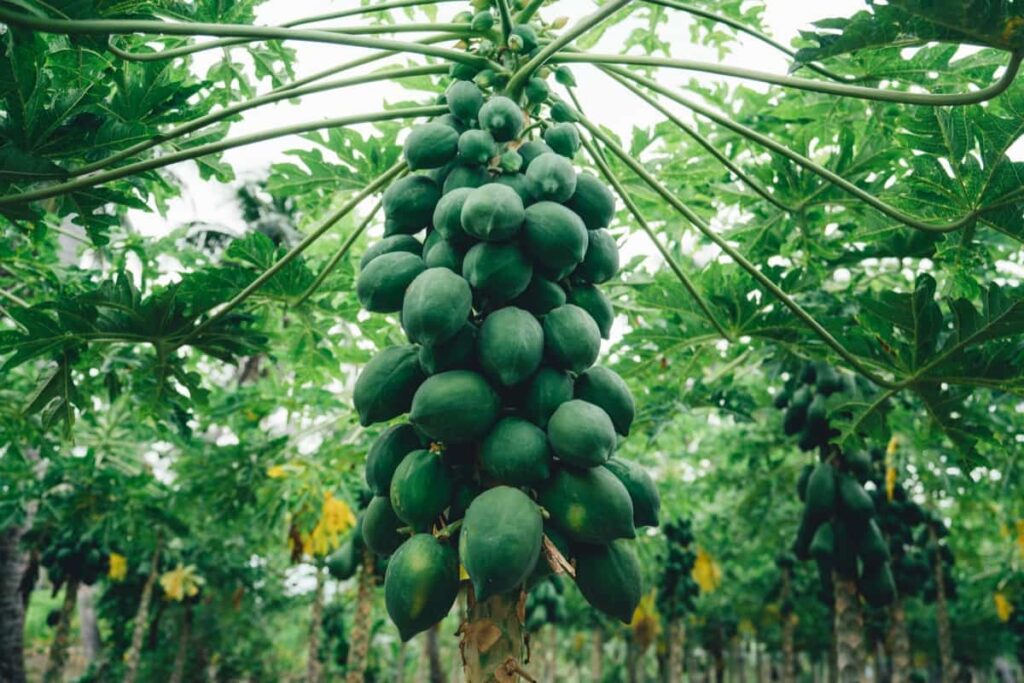
This guide will walk you through each month’s essential tasks, including soil preparation, planting, irrigation, fertilization, pest control, pruning, and harvesting. With the right knowledge Package and practices, you can optimize your papaya orchard’s productivity and ensure a bountiful harvest throughout the year.
Papaya Orchard Management
What is Papaya Farming and its Overview?
Papaya, also known as pawpaw, is a tropical fruit packed with vitamin C and renowned for its medicinal properties. It originates from Costa Rica and southern Mexico and has become a globally cultivated fruit. India holds the top position in papaya production worldwide, followed by Brazil, Mexico, Nigeria, Indonesia, Peru, China, Thailand, and the Philippines. In India, papaya is grown on a large scale and commonly cultivated as a kitchen garden crop due to its high productivity and ease of cultivation.
Belonging to the Caricaceae family and scientifically known as Carica papaya, the plant exhibits three sexes: male, female, and hermaphrodite. Growing up to 16 to 33 feet tall, the plant remains unbranched unless there is damage to the stem apex. Its fan-shaped leaves have long stalks, while the flowers come in two forms. Male flowers have fused stamens and petals, while female flowers feature contorted petals with a superior ovary. The flowers typically open at night, attracting pollinating moths. When ripe, papaya fruits vary in shape from oblong to spherical and display a vibrant orange color.
Importance of Month-Wise Planning for Papaya Orchard Operations
- Month-wise planning is crucial for papaya orchard operations to maximize productivity and ensure optimal growth and fruit yield.
- Proper planning helps schedule activities such as planting, pruning, fertilization, irrigation, pest control, and harvesting at the right time.
- It allows farmers to take advantage of favorable weather conditions and minimize the risk of crop damage.
- Timely operations result in healthier trees, improved fruit quality, increased market value, and higher profitability.
- A well-executed month-wise plan can lead to a consistent and abundant supply of papayas throughout the year, meeting market demand effectively.
In case you missed it: Optimizing Coconut Orchard Operations: A Comprehensive Management Guide for Month-wise Planning
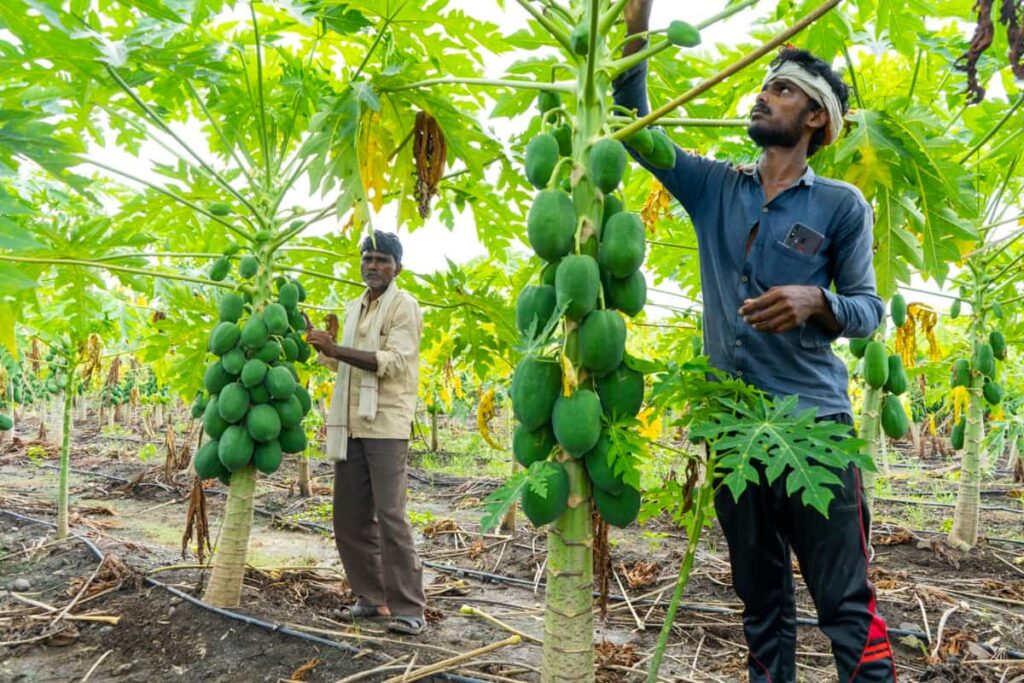
Best Tips for Growing Papaya Orchard Operations Practices
Climate for Papaya Cultivation
- Papaya requires high humidity and temperature levels, avoiding frost and heavy rainfall.
- Papaya grows best at sea level up to 600m altitude; beyond that, fruit quality may decrease.
- Tropical papaya. Papaya grows in subtropical climates without frost. Papaya growing requires 22–26°C but no lower than 10°C. Papaya thrives in summer temperatures between 38°C and 43°C.
- Papaya is damaged by extreme cold and frost. Papaya requires high temperature, low humidity, and enough moisture.
Soil Requirements
- Papaya adapts to different soils but prefers rich, sandy loam or alluvial soil.
- Papaya grows well in light, fertile sandy loam or loamy soil with watering and drainage.
- It grows well in medium-black and alluvial soil. Soil pH should be 6.5–7.5.
- Well-drained soil that allows water to drain easily is essential.
- Neutral to near-neutral soil with a pH between 5.5 and 7.5 is suitable for papaya cultivation.
Improved Varieties
- Red Lady 786 is a popular hybrid variety with high storage capacity and yield.
- Pusa Dwarf: Dwarf plants with fruits growing at 25-30 cm height and weighing 1-1.5 kg.
- Pusa Giant: Tall plants with fruits growing at 50-75 cm height and weighing 2-3 kg.
- Pusa Delicious: Medium-sized fruits growing at 40-50 cm in height, weighing 1.5-2.0 kg.
- Coorg Honey Dew: Medium-sized fruits with light stripes and oval shapes.
- Washington: Tall variety with purple nodes and yellow flowers, oval-shaped fruits starting from a height of 1.5 meters.
- Arka Surya: Gynodioecious hybrid variety with a high yield of medium-sized fruits (600-800 g).
- Red Lady papaya is a popular variety known for its large fruit size.
Other varieties include Coimbatore-1, Coimbatore-2, Pusa Nanha, Pusa Papaya-1, Pusa Majesty, Arka Prabhath, and Ranchi.
Preparation of Papaya Nursery
- Create beds 10-15 cm high and 1.5 meters wide.
- Mix decomposed Farm Yard Manure into the beds.
- Treat the seeds with Thiram before sowing.
- Sow the seeds at a depth of 1.5 cm, spacing them 15 cm apart.
- Cover with compost and soil mixture and water regularly.
- Transplant the seedlings into polythene bags at 8-10 cm height.
- After a month, the plants are ready for field planting.
In case you missed it: Optimizing Sweet Orange Orchard Management: A Month-By-Month Operation Guide for Maximum Yield
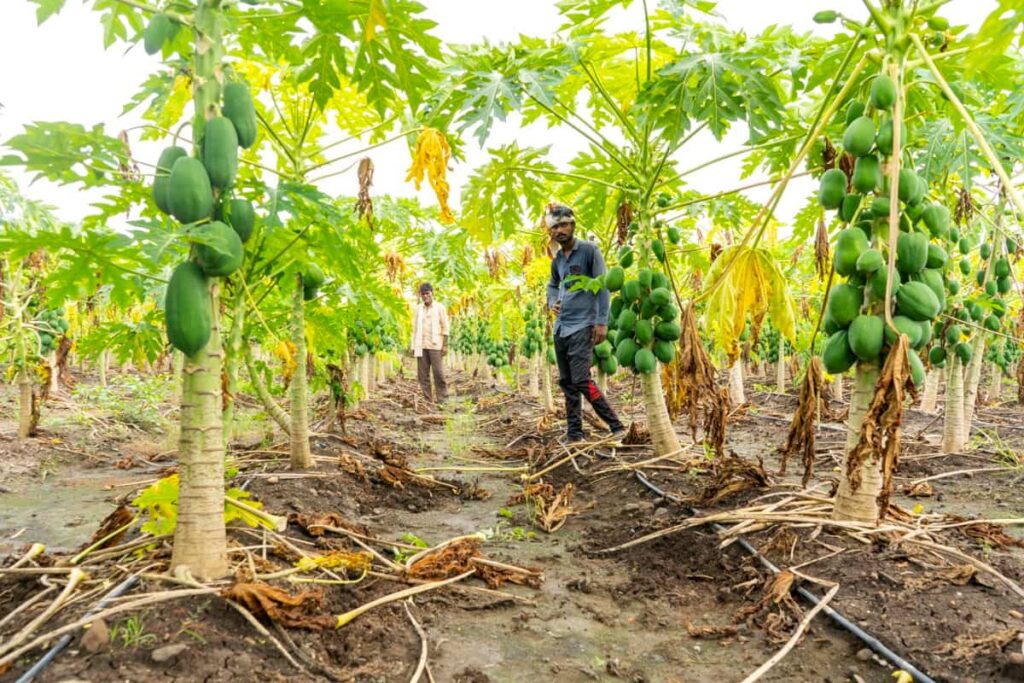
Planting Season
- Papaya plants can be planted three times a year: at the rainy season (June-July), at the end of the rainy season (September-October), and during the spring season (February-March). The optimal time for transplanting papaya is in June-July.
- Planting should be avoided during winter due to frost risks.
- Consider rain, frost, and hot air while selecting the planting time.
Papaya Plantation Method
- Prepare and level the field to avoid water accumulation.
- Dig pits of size 505050 cm at a spacing of 1.5*1.5 meters.
- Fill each pit with 20 kg of decomposed Farm Yard Manure and 1.25 kg bone powder mixed with soil.
- For tall-growing varieties, maintain a spacing of 1.8*1.8 meters in rows of pits.
- When seedlings reach 20-25 cm in height, plant two in each pit, spaced 30 cm apart.
- Preferably, plant in the evening and irrigate after transplanting the seedlings.
Watering
- Water requirements vary depending on environmental factors and plant age.
- Young papaya plants need more moisture compared to mature trees.
- Water papaya every 9-10 days in South India and 6-7 days in summer. In northern India, irrigate twice a week.
- Irrigation frequency ranges from once or twice a week for seedlings to every 15 days for fruit-bearing trees.
Crop Rotation
- Papaya can be rotated with sugarcane, bamboo, cereals, or reeds.
- This practice helps in managing soil fertility and preventing diseases.
- Intercropping: Ginger, peas, and fenugreek can be grown alongside papaya. Light weeding is necessary after each irrigation.
- Before fruiting, intercrop vegetables. After bearing, intercropping is not recommended. Intercrops include mung, did, onion, horse gram, and green vegetables.
- Male plant removal: After flowering, keep only 10% of male plants for pollination and remove the rest.
- Fruit thinning: Remove small unnecessary fruits to promote the growth of bigger and shapelier fruits. A papaya plant yields around 50 fruits per year.
- Weeding: Hoeing or tilling, usually weeds. Herbicides like Diuron @2.0-2.5 kg a.i/ha or Glyphosate @1-2 kg/ha worked well.
Thinning
- 6–7 months after transplanting, papaya plants flower. At flowering, remove surplus plants to maintain a 10:1 female: male plant ratio and one plant per pit.
- For pollination, male plants should be scattered across the field.
Planting Material
- Papaya is commercially propagated through seeds.
- Tissue culture techniques are available but limited to laboratories.
- Seeds should be planted in nurseries and transplanted after 6-8 weeks.
Land Preparation
- Papaya orchards require well-protected land with windbreaks and good drainage.
- Pits with organic matter and soil are prepared before transplantation.
- Intercropping can be practiced with compatible crops during the initial stages.
In case you missed it: Optimizing Cashew Orchard Management: A Month-by-Month Operation Guide for Maximum Yield
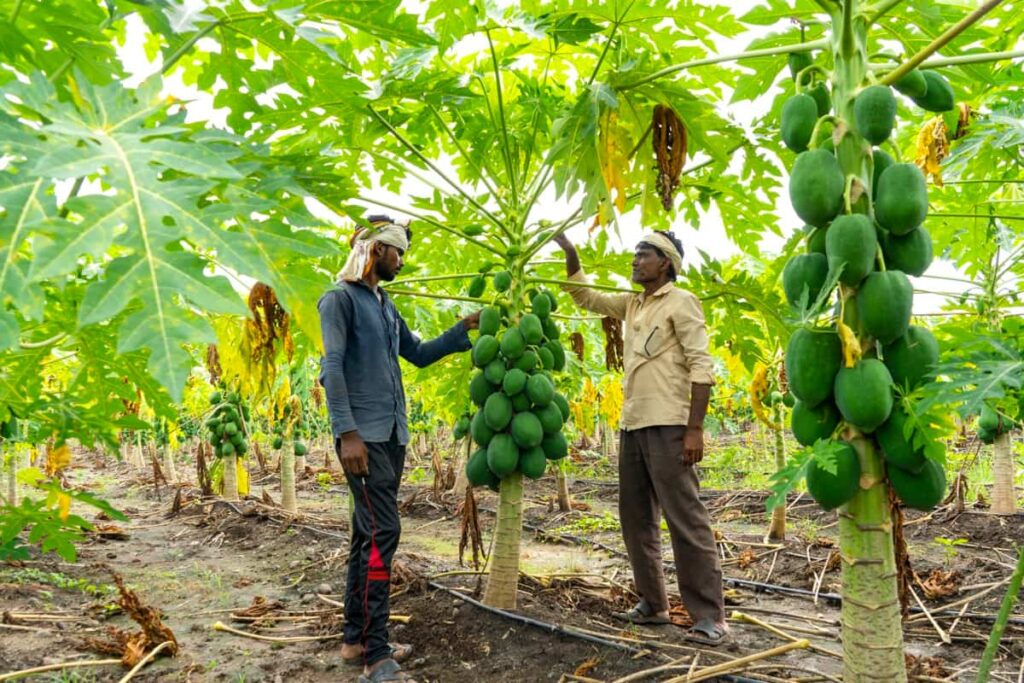
Pest and Disease Management
- Common diseases in papaya cultivation include anthracnose, powdery mildew, stem rot, and damping off.
- Effective control measures include using fungicides and maintaining proper drainage.
- Red spider mite: Control with Cypermethrin 0.15% solution.
- Stem or root rot: Improve drainage, remove affected plants, and spray with Bordeaux mixture or copper oxychloride.
- Damping off: Treat seeds with Thiram and use formaldehyde solution in the seedbed.
- Leaf curl and mosaic: Uproot and dispose of affected plants, spray with cypermethrin solution and avoid growing pumpkin-class vegetables.
- Pest management involves controlling aphids, red spider mites, stem borers, fruit flies, weevils, and grasshoppers.
Harvesting
- Papayas are harvested when they reach the desired size and develop a yellow tinge at the apex.
- Each variety has specific ripening characteristics, with some turning yellow and others remaining green.
- Harvest papaya when fruits reach full size and start turning yellow. Ripen fruits artificially by storing them in sacks or wrapped in paper.
- Papaya yield depends on various factors, with 25-100 fruits per plant and weights ranging from 500g to 3kg.
- A well-managed orchard can yield 75-100 tonnes per hectare in one crop year.
- Proper handling and packaging post-harvest is crucial to maintain fruit quality.
January Month Papaya Orchard Operations Planning
- Evaluate the existing orchard and assess its performance.
- Conduct soil testing and amend the soil if necessary.
- Prepare the land for new plantations by clearing and leveling.
- Start preparing the papaya nursery for seedling production.
- Plan and procure necessary inputs for the upcoming season.
February Month Papaya Orchard Operations Planning
- Continue preparing the nursery beds and sow papaya seeds.
- Implement pest and disease management strategies in the nursery.
- Irrigate the nursery regularly and provide shade if required.
- Monitor seedling growth and ensure optimal conditions for germination.
March Month Papaya Orchard Operations Planning
- Continue monitoring seedling growth and provide the necessary care.
- Prepare the field for planting by digging pits and adding organic matter.
- Control weeds in the field and ensure proper drainage.
- Conduct irrigation based on weather conditions and seedling requirements.
- Plan for intercropping with ginger, peas, or fenugreek.
In case you missed it: The Ultimate Month-by-Month Guide to Custard Apple Orchard Management
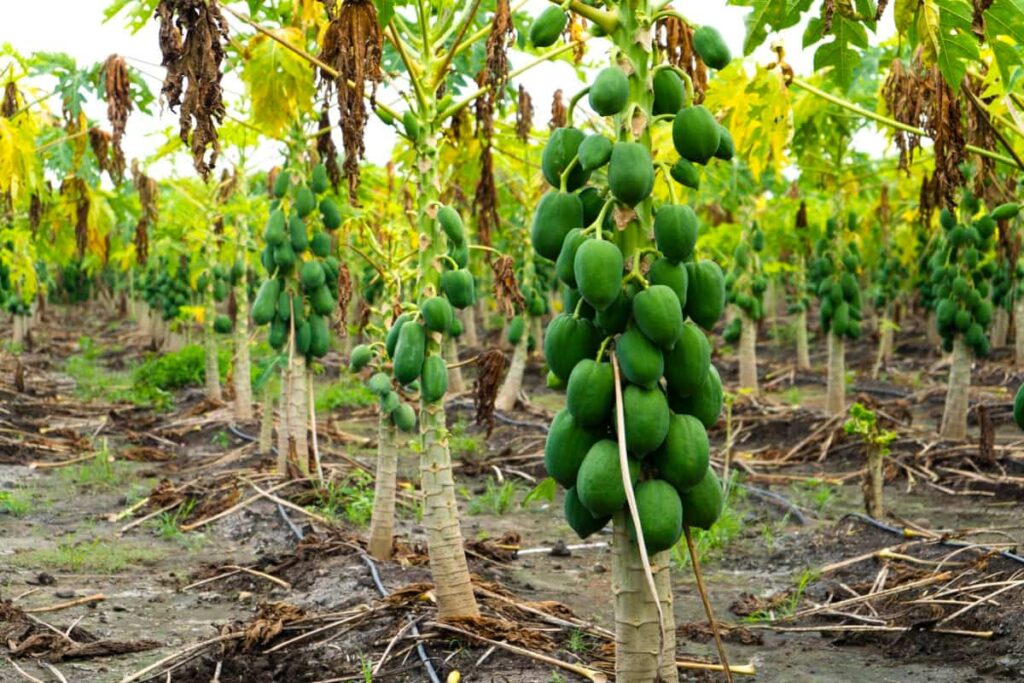
April Month Papaya Orchard Operations Planning
- Transplant healthy and sturdy seedlings into polythene bags.
- Place the polythene bags in a shaded area for a few days, gradually exposing them to sunlight.
- Collect soil samples at every one-foot depth from the profile pit for analysis.
- A soil pH of up to 7.5 is considered suitable for papaya plantations based on the soil test report.
- Maintain irrigation and provide adequate nutrients to the seedlings.
- Monitor intercropping and control weeds around the trees.
- Monitor pests and diseases and apply appropriate control measures.
May Month Papaya Orchard Operations Planning
- Perform summer plowing with an MB plow twice and level the land.
- Mark the alignment and pegs for pit digging, with a 2.5×2.5m/ 5x5m spacing between rows.
- Dig pits of 60x60x60 cm size, placing the topsoil to the right and the bottom soil to the left.
- Expose the pits to sunlight for at least two weeks before filling them to control soil-borne pests and diseases.
- Continue nurturing the seedlings in polythene bags, ensuring proper irrigation and nutrition.
- Prepare the main field for transplantation by incorporating organic matter.
- Implement trellising or staking systems for tall-growing varieties.
- Finalize intercropping practices and manage weeds effectively.
- Monitor the weather conditions and adjust irrigation accordingly.
June Month Papaya Orchard Operations Planning
- Begin the main planting season for papaya.
- Transplant the healthy seedlings from polythene bags into the prepared field.
- Fill the pits with a mixture of topsoil, 20 kg of Farm Yard Manure (FYM), 1 kg of Single Super Phosphate, and 100 gm of 10% Follidol dust per pit.
- Fill the pits with soil to a level 6 inches above the ground, allowing it to settle at the ground level when planting.
- Take care of no damage to the roots during transplantation.
- Water the newly transplanted seedlings immediately after planting.
- Monitor for pests, diseases, and weed growth regularly.
July Month Papaya Orchard Operations Planning
- Continue monitoring the growth of the transplanted seedlings.
- Provide regular irrigation, especially during dry spells.
- Monitor and control pests and diseases using appropriate measures.
- Monitor intercropped plants and manage weeds effectively.
- Evaluate the need for additional nutrient application and adjust accordingly.
August Month Papaya Orchard Operations Planning
- Focus on irrigation management as rainfall decreases.
- Monitor the overall health and growth of the papaya plants.
- Prune the plants if necessary to maintain a balanced structure.
- Continue managing pests, diseases, and weeds.
- Assess the success of intercropping and take necessary actions.
September Month Papaya Orchard Operations Planning
- Continue monitoring and managing the growth of the papaya plants.
- Evaluate the need for supplementary nutrition and apply as required.
- Monitor and control pests and diseases effectively.
- Prepare for the end of the rainy season and adjust irrigation practices accordingly.
- Evaluate the performance of intercropped plants and make adjustments if necessary.
October Month Papaya Orchard Operations Planning
- Harvest ripe fruits based on size, color, and taste.
- Implement proper post-harvest handling and storage techniques.
- Conduct gap filling if any plants have died, replacing them promptly.
- Work the soil in the basins to keep them weed-free and improve aeration.
- Cut the growing shoot to encourage lateral branches.
- Optionally, sow intercrops for the rabi season.
November Month Papaya Orchard Operations Planning
- Focus on post-harvest activities, including packaging and marketing of harvested fruits.
- Clean and maintain the orchard by removing fallen leaves and debris.
- Monitor and manage pests, diseases, and weeds for healthy plant growth.
- Plan for the upcoming season, including ordering necessary inputs.
In case you missed it: Optimizing Fig/Anjeer Orchard Management: A Month-by-Month Operation Guide for Maximum Yield
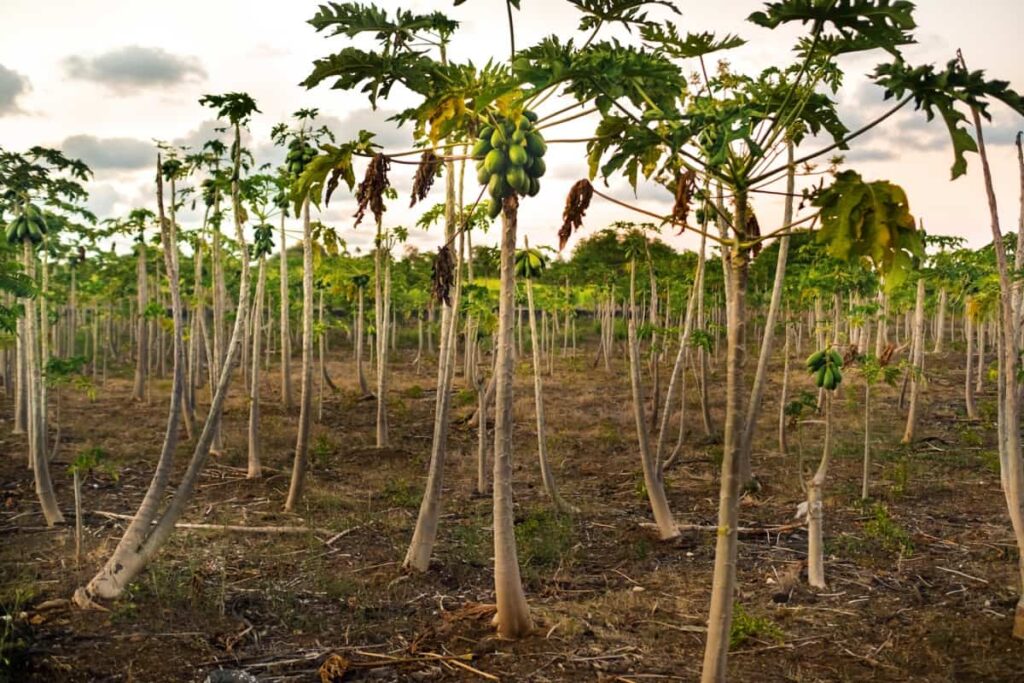
December Month Papaya Orchard Operations Planning
- Conduct a comprehensive assessment of the orchard’s performance for the year.
- Analyze the yield, quality, and overall success of the papaya orchard.
- Make necessary adjustments to the management practices based on the assessment.
- Plan for the next season, including soil preparation, Plan for the next season, including soil preparation, nursery management, and procurement of planting materials.
- Conduct soil testing and amend the soil if required.
- Maintain the orchard by pruning and removing dead or diseased plants.
- Implement pest and disease control measures during the dormant season.
- Evaluate the intercropping practices and make adjustments if needed.
- Plan for any necessary infrastructure improvements or repairs in the orchard.
- Review and update irrigation schedules based on weather patterns and plant needs.
Conclusion
Growing papaya requires careful attention and adherence to specific tasks throughout the year. From soil suitability assessment to irrigation, pruning, and pest control, following a month-by-month guide ensures optimal growth and successful cultivation of papaya orchards.
- How to Raise Pigs in Your Own Backyard: A Comprehensive Guide
- Budget Friendly Sheep Shed Ideas: Cheap and Low-Cost Tips
- How Much Do Cattle Farmers Make: Revenue Streams in Cattle Farming
- Management Pests and Diseases in Your Cotton Field
- Sheep Farming Business Plan for Beginners
- Aquaponic Farming at Home: A Step-By-Step Guide
- Profitable Village Farming Business Ideas in 2024
- High-Yield Aquaculture: Fast-Growing Fish for Farming
- Effective Fish Pond Construction Techniques for Beginners
- Irrigation and Water Management in Pineapple Farming
- Blossom to Harvest: Mastering Flowering and Pollination in Papaya Farming
- Pig Fattening Essentials: From Selection to Sale for Beginners
- Raising Wagyu Cattle: A Complete Guide for Premium Beef Production
- Soil Types and Their Water Holding Capacity
- Optimizing Irrigation Schedules for Coconut Groves for Enhanced Yield
- Espresso Your Garden: Coffee Grounds for Healthier Acid-Loving Plants
- The Best Soil Mix for Snake Plants: How to Mix Your Own Snake Plant Soil
- Green Thumb Success: Expert Tips for Cultivating Greenhouse Beans All Year Round
- Bloom All Year Round: The Ultimate Guide to Indoor Hyacinth Care
- Eco-Friendly Gardening: How to Make Liquid Fertilizer from Kitchen Waste
- Ultimate Guide to Grow Anise in Pots: Explore Seed Propagation to Harvesting
- Guide to Raising Chester White Pigs: Discover Breed Facts to Growth Management
- Mastering the Elegance: The Ultimate Guide to Weeping Cherry Tree Care, Planting, and Maintenance
- Ultimate Guide to Planting Garlic in Grow Bags: Growing Strategies for Beginners
- How to Fix Spider Plant Leaf-Related Problems: Natural and Organic Remedies
- 10 Reasons Why Your Tulsi Plant is Shedding Leaves: Home Remedies and Solutions
- Optimizing Growth and Yield: The Advantages of Palm Bunch Ash Fertilizer
- Utilizing Neem Oil Extract as a Natural Pesticide for Hydrangea
- From Soil to Harvest: Various Ways in Which Farmers Can Use AI Tools
- Steps to Encourage and Induce Citrus Flowers: A Comprehensive Guide
- How to Fix Snake Plant Leaf-Related Issues: Natural and Organic Remedies
- Transform Your Garden into a Fragrant Oasis with Raat Ki Rani (Night Blooming Jasmine)
- Discover the Ideal Chicken Breeds for Philippine Farms
- How to Create a Poultry Egg Farm Business Plan for Profits
- Grow Lemon Cucumbers Like a Pro: Insider Techniques for Bountiful Yields
- Ultimate Guide to Caring for Your Pink Princess Philodendron: Tips for Thriving Variegation
